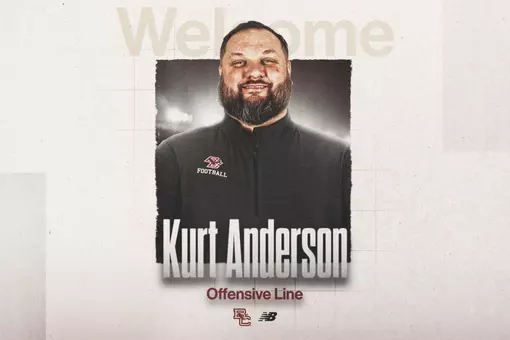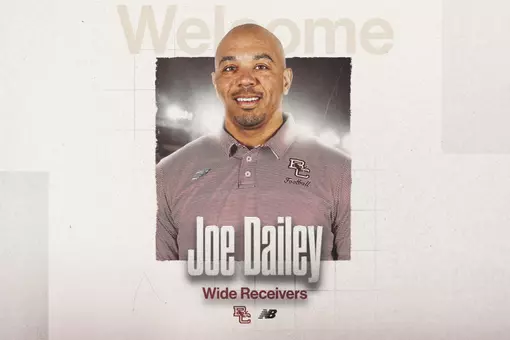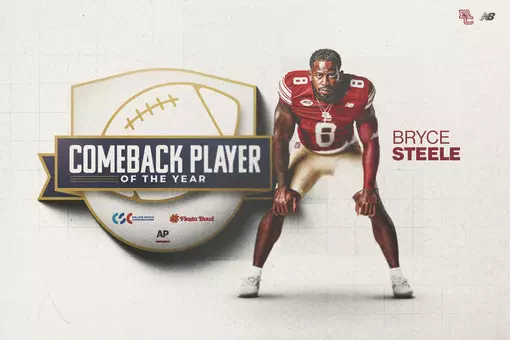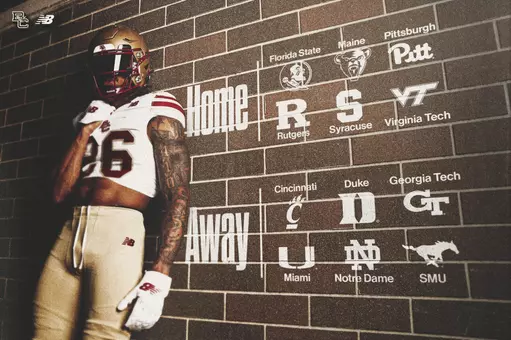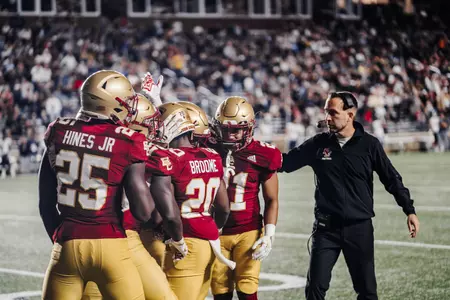
At UConn, A Trip Into New England's Football Past
October 27, 2022 | Football, #ForBoston Files
It wasn't too long ago that Hartford nearly replaced Massachusetts as the center of New England football.
Located along Route 1 in Foxboro, Massachusetts, Gillette Stadium is a hulking tribute to the championship era of the New England Patriots. It opened with a Super Bowl banner, and as Lombardi Trophies migrated to One Patriot Place, the spoils of success propped up around a stadium that became synonymous with winning. A shopping and events center turned a little-known section of the region into an entertainment destination, all while the tradition of winning stood at the epicenter of its construction.
Seeing the stadium appear along that stretch of road makes it easy to forget how the Patriots and owner Robert Kraft once nearly moved the team out of Massachusetts. They were never going to leave the region - Kraft saw to that when he bought the team from previous owner James Orthwein - but had fortunes ended differently, the stadium would have lined the waterfront of Hartford, Connecticut instead of being nestled into the woods of a small Massachusetts town close to the Rhode Island state border.
That stadium - the one that never happened - would have represented a sincere power shift in the New England region, and as Boston College heads to play Connecticut this weekend, a quick trip through history helps define how Rentschler Field, the home stadium of the Huskies and the site of Saturday's game, is a standing reminder of an era that almost saw Hartford replace Boston as the football power player of the region because of the legendary disaster of old Foxboro Stadium.
Its design was never a beautiful palace, but the cheap, bare bones construction at Schaefer Stadium (and, later, Sullivan Stadium before it's final moniker) outlived its usefulness by the time owner Victor Kiam sold the team to Orthwein, a descendent of the famous Busch family. The deal didn't include the physical stadium, but Orthwein intended to buy out the lease that Robert Kraft acquired after Billy Sullivan went bankrupt following a series of poor investments in the 1980s. His goal was to move the team to St. Louis, but those efforts proved unsuccessful after Kraft refused to break the lease and eventually bought the team from an owner who wanted nothing to do with a franchise he couldn't move.
That power play essentially saved professional football in New England, but it didn't change the fact that Foxboro Stadium was woefully obsolete for the NFL of the mid-1990s. The town itself was in a difficult area of Massachusetts, and the entire infrastructure lacked luxury boxes or modern amenities. The area around the stadium was barren, and dirt parking lots were the norm. There was no exit or egress from Route 1, the road leading to the stadium, and people had to navigate a crippling traffic pattern that backed up for hours on game day. Inside the stadium, seatbacks didn't exist, and the plumbing failed on a semi-regular basis.
The only positive remained its permanence to a franchise that spent its first decade living a nomadic life, but a desperate need for options existed given Foxboro's concrete building. Ownership wanted to self-fund a stadium but needed cooperation from the Commonwealth of Massachusetts for necessary infrastructure upgrades. When the process balked, wandering eyes started popping up within the greater region.
The most competitive offer came from Connecticut, where the city of Hartford sat without a top-flight franchise after the NHL's Whalers left for a non-traditional sports market in the Carolinas. The state itself was a competitor of sorts to Massachusetts' regional dominance, and governor John Rowland saw the Patriots as a gateway to a reinvention and reimagining of the Hartford waterfront.
He proposed a $372 million, state-of-the-art stadium that would stand as the crown jewel of a new business district at the site of the Hartford Steam Plant. The Patriots would easily become the most lucrative franchise in football, and the University of Connecticut, a Division I-AA champion in the Yankee Conference, would share the facility much like how Pittsburgh played at Three Rivers Stadium or how Veterans Stadium and Lincoln Financial Field provided home services for Temple. Both of those schools were in the Big East for football, and an anticipated move meant UConn would exit the small, on-campus Memorial Stadium for a bigger, better facility while simultaneously answering questions about the Huskies' intentions to move into the football league of their all-sports conference.
None of that, of course, came to fruition, and the materialized deal fell apart. Kraft returned to Massachusetts and built Gillette Stadium as the centerpiece of Patriot Place, and Connecticut, now driven to build a world-class stadium, threw its funding into a different area located in East Hartford at the World War II-era airfield Rentschler Field. A slightly smaller project became the home stadium for the Huskies and opened in 2003 as the first new college football facility constructed in the 21st century, and UConn, still bitten by the dream of big time college football, transitioned into Division I-A in 2000 before joining the Big East in 2004. In 2010, after going 5-2 in conference to tie Pittsburgh and West Virginia, the program won the league's autobid to the Bowl Championship Series and appeared in the Fiesta Bowl.
"They were really good when I was in the Big East," BC head coach Jeff Hafley said. "Donald Brown was their running back, and Dan Orlovsky played there and was a really good player for them. They had a good quarterback and good wideouts. We had some really, really good battles when I was at Pitt, and [Rentschler Field] was honestly a loud, tough place to play. We lost a night game [when] we were really good at Pitt one year, and it was a really, really loud, good environment. I have a ton of respect for that program. From my experience in the Big east, that was a tough game."
That UConn's rise was somehow linked to the Patriots' stadium drama and subsequent border battle between Massachusetts and Connecticut is a sign of how intertwined this matchup between New England schools can feel. It's a very fractured and parochial place at times as communities constantly measure themselves against one another, but the stadium issue felt like the capstone point of the rivalry between the two states. Hartford eventually did reinvent itself as the home to popular and competitive minor league franchises, but the potential college battles between Connecticut and Boston College turned into a bitter rivalry during the realignment phase of the 2000s to the point that they didn't play one another until 2016.
The Huskies have never beaten the Eagles on the gridiron, but Saturday's game marks just the second time the Massachusetts power team travels to East Hartford (UConn was designated the home team in 2017 when the game at Rentschler Field moved to Fenway Park). Even as both teams jockey for their next win, it will feel like a postseason Super Bowl or a blood feud between states who are usually aligned within the national geopolitical scene. Both schools recruit the same areas, and while BC has the ACC and its power conference affiliation, UConn remains a viable option specifically for college football players who want to experience the northeast.
A game against one another feels almost natural, and though Massachusetts and Boston remain unquestionably the central heartbeat of the New England region, the occasional challenge from Hartford is a good reminder of how strong this area feels about its teams, its communities, and its state pride.
Boston College and Connecticut kick off on Saturday at 12 p.m. from Rentschler Field at Pratt and Whitney Stadium in East Hartford, Connecticut. The game can be seen on CBS Sports Network with additional coverage available through CBSSports.com. Radio coverage is also available through the BC Learfield IMG Sports Network, with local coverage in Boston on WEEI 93.7 FM.
Seeing the stadium appear along that stretch of road makes it easy to forget how the Patriots and owner Robert Kraft once nearly moved the team out of Massachusetts. They were never going to leave the region - Kraft saw to that when he bought the team from previous owner James Orthwein - but had fortunes ended differently, the stadium would have lined the waterfront of Hartford, Connecticut instead of being nestled into the woods of a small Massachusetts town close to the Rhode Island state border.
That stadium - the one that never happened - would have represented a sincere power shift in the New England region, and as Boston College heads to play Connecticut this weekend, a quick trip through history helps define how Rentschler Field, the home stadium of the Huskies and the site of Saturday's game, is a standing reminder of an era that almost saw Hartford replace Boston as the football power player of the region because of the legendary disaster of old Foxboro Stadium.
Its design was never a beautiful palace, but the cheap, bare bones construction at Schaefer Stadium (and, later, Sullivan Stadium before it's final moniker) outlived its usefulness by the time owner Victor Kiam sold the team to Orthwein, a descendent of the famous Busch family. The deal didn't include the physical stadium, but Orthwein intended to buy out the lease that Robert Kraft acquired after Billy Sullivan went bankrupt following a series of poor investments in the 1980s. His goal was to move the team to St. Louis, but those efforts proved unsuccessful after Kraft refused to break the lease and eventually bought the team from an owner who wanted nothing to do with a franchise he couldn't move.
That power play essentially saved professional football in New England, but it didn't change the fact that Foxboro Stadium was woefully obsolete for the NFL of the mid-1990s. The town itself was in a difficult area of Massachusetts, and the entire infrastructure lacked luxury boxes or modern amenities. The area around the stadium was barren, and dirt parking lots were the norm. There was no exit or egress from Route 1, the road leading to the stadium, and people had to navigate a crippling traffic pattern that backed up for hours on game day. Inside the stadium, seatbacks didn't exist, and the plumbing failed on a semi-regular basis.
The only positive remained its permanence to a franchise that spent its first decade living a nomadic life, but a desperate need for options existed given Foxboro's concrete building. Ownership wanted to self-fund a stadium but needed cooperation from the Commonwealth of Massachusetts for necessary infrastructure upgrades. When the process balked, wandering eyes started popping up within the greater region.
The most competitive offer came from Connecticut, where the city of Hartford sat without a top-flight franchise after the NHL's Whalers left for a non-traditional sports market in the Carolinas. The state itself was a competitor of sorts to Massachusetts' regional dominance, and governor John Rowland saw the Patriots as a gateway to a reinvention and reimagining of the Hartford waterfront.
He proposed a $372 million, state-of-the-art stadium that would stand as the crown jewel of a new business district at the site of the Hartford Steam Plant. The Patriots would easily become the most lucrative franchise in football, and the University of Connecticut, a Division I-AA champion in the Yankee Conference, would share the facility much like how Pittsburgh played at Three Rivers Stadium or how Veterans Stadium and Lincoln Financial Field provided home services for Temple. Both of those schools were in the Big East for football, and an anticipated move meant UConn would exit the small, on-campus Memorial Stadium for a bigger, better facility while simultaneously answering questions about the Huskies' intentions to move into the football league of their all-sports conference.
None of that, of course, came to fruition, and the materialized deal fell apart. Kraft returned to Massachusetts and built Gillette Stadium as the centerpiece of Patriot Place, and Connecticut, now driven to build a world-class stadium, threw its funding into a different area located in East Hartford at the World War II-era airfield Rentschler Field. A slightly smaller project became the home stadium for the Huskies and opened in 2003 as the first new college football facility constructed in the 21st century, and UConn, still bitten by the dream of big time college football, transitioned into Division I-A in 2000 before joining the Big East in 2004. In 2010, after going 5-2 in conference to tie Pittsburgh and West Virginia, the program won the league's autobid to the Bowl Championship Series and appeared in the Fiesta Bowl.
"They were really good when I was in the Big East," BC head coach Jeff Hafley said. "Donald Brown was their running back, and Dan Orlovsky played there and was a really good player for them. They had a good quarterback and good wideouts. We had some really, really good battles when I was at Pitt, and [Rentschler Field] was honestly a loud, tough place to play. We lost a night game [when] we were really good at Pitt one year, and it was a really, really loud, good environment. I have a ton of respect for that program. From my experience in the Big east, that was a tough game."
That UConn's rise was somehow linked to the Patriots' stadium drama and subsequent border battle between Massachusetts and Connecticut is a sign of how intertwined this matchup between New England schools can feel. It's a very fractured and parochial place at times as communities constantly measure themselves against one another, but the stadium issue felt like the capstone point of the rivalry between the two states. Hartford eventually did reinvent itself as the home to popular and competitive minor league franchises, but the potential college battles between Connecticut and Boston College turned into a bitter rivalry during the realignment phase of the 2000s to the point that they didn't play one another until 2016.
The Huskies have never beaten the Eagles on the gridiron, but Saturday's game marks just the second time the Massachusetts power team travels to East Hartford (UConn was designated the home team in 2017 when the game at Rentschler Field moved to Fenway Park). Even as both teams jockey for their next win, it will feel like a postseason Super Bowl or a blood feud between states who are usually aligned within the national geopolitical scene. Both schools recruit the same areas, and while BC has the ACC and its power conference affiliation, UConn remains a viable option specifically for college football players who want to experience the northeast.
A game against one another feels almost natural, and though Massachusetts and Boston remain unquestionably the central heartbeat of the New England region, the occasional challenge from Hartford is a good reminder of how strong this area feels about its teams, its communities, and its state pride.
Boston College and Connecticut kick off on Saturday at 12 p.m. from Rentschler Field at Pratt and Whitney Stadium in East Hartford, Connecticut. The game can be seen on CBS Sports Network with additional coverage available through CBSSports.com. Radio coverage is also available through the BC Learfield IMG Sports Network, with local coverage in Boston on WEEI 93.7 FM.
Men's Basketball: UMass Postgame Press Conference (Dec. 10, 2025)
Thursday, December 11
Women's Basketball: Bryant Postgame Press Conference (Dec. 9, 2025)
Wednesday, December 10
Rowing: Christmas Music
Tuesday, December 09
Rowing: Favorite Thanksgiving Food
Tuesday, December 09

